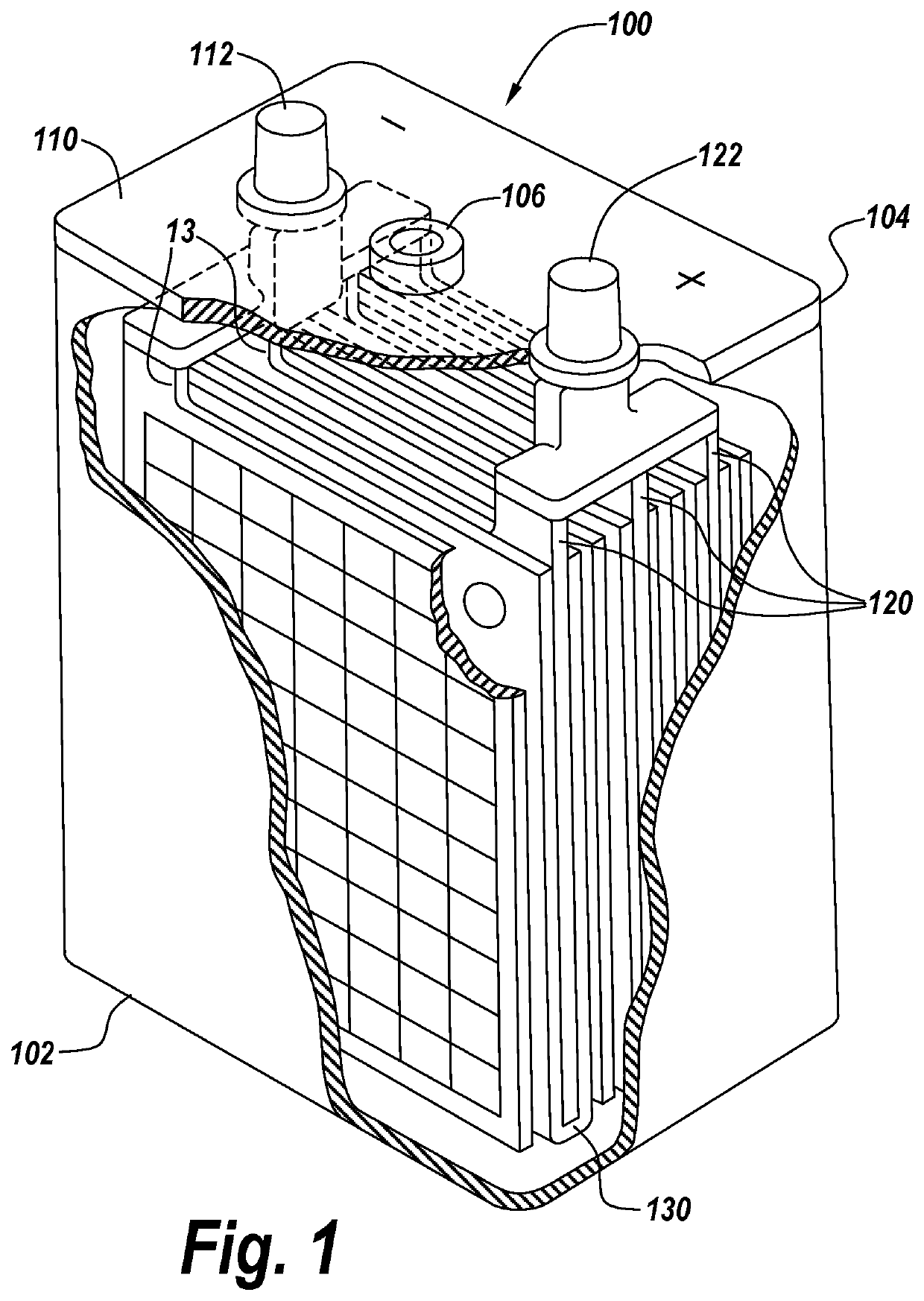Glass compositions with leachable metal oxides and ions
a technology of metal oxides and glass compositions, applied in the field of glass compositions with leachable metal oxides and ions, can solve the problems of flooded batteries, flooded batteries, flooded batteries, valve-regulated lead acid (“vrla”), and complex acid batteries, and complicating battery recharging is a charge imbalance between the negative plate(s)
- Summary
- Abstract
- Description
- Claims
- Application Information
AI Technical Summary
Benefits of technology
Problems solved by technology
Method used
Image
Examples
example 1
ties and Ground Particles
[0633]Glass melts were made with the following metal oxides mixed into the sand and other ingredients. The basic glass composition can generally be described as 66.25% SiO2, 3.5% Al2O3, 5.6% CaO, 2.8% MgO, 5.5% B2O3 and 14% NaO with the amount of SiO2 varied to accommodate from 0.4% to 6% of added metal oxide. The dissolvability of the glass in electrolyte can be increased or decreased based on the percent of boron and sodium oxide in the melt.
[0634]Specific glass melts produced contained the following components:
[0635]
TABLE 10Specific Glass CompositionsAntimonyCompositionNickelCompositionTitaniumCompositionTinCompositionOxideweight, %Oxideweight, %Oxideweight, %Oxideweight, %SiO266.5SiO266.55SiO266.55SiO266.25Al2O33.5Al2O33.5Al2O33.5Al2O33.5CaO5.6CaO5.6CaO5.6CaO5.6MgO2.8MgO2.8MgO2.8MgO2.8B2O35.5B2O35.5B2O35.5B2O35.5K2O1.7K2O1.7K2O1.7K2O1.6Na2O14Na2O14Na2O14Na2O14Sb2O30.4NiO0.35TiO20.35SnO20.75Total100Total100Total100Total100CopperCompositionCobaltCompositio...
example 2
Measurements
[0636]Glass patties were made as described in Example 1 and were then ground into particles for leaching test and electrochemical tests. Particle sizes were selected to approximate the surface area of fibers to determine efficiency of metal ion dissolution and surface-side reactions on the negative electrode to consume electrical current. Exemplary particle size distributions are shown in Tables 11 and 12.
[0637]Particle size, surface area, and fiber diameter correlations are shown in FIGS. 34-36. The particle size, based on average particle diameter, can be translated to fiber diameter by surface area, as the surface area is a common attribute. The surface area of an object affects how fast the object (i.e., a glass fiber or glass particle) is dissolved by the electrolyte and the resulting concentration of metal ions in the electrolyte. The relationship is summarized in the equation y=1.5402*x−1.013. From this relationship the surface area (y) in m2 / g of a fiber of known...
example 4
Diameter and Solution Conditions on Glass Dissolution
[0652]Dissolution of glass fibers is dependent on two major factors. The first factor is the character of the solvent or electrolyte. Glass dissolves about twice as fast under alkaline conditions (pH-10) than under neutral or water-type pH (pH 5 to 8). Glass does dissolve more readily when soaked in acid electrolyte (35% H2SO4) than under neutral conditions, but still far less than the dissolution observed under alkaline conditions. Fiber diameter also plays a role since the finer diameter fibers have higher surface area and more glass exposed to the solution. Under these conditions, two different sized glass particles were studied that correspond to a 0.8 micron fiber (2.1 m2 / g BET SSA) and a 1.4 micron fiber (1.2 m2 / g BET SSA). The results in FIG. 24 show that for the coarser particles (equivalent to 1.4 micron fiber) the dissolution in water is actually greater than in acid. However, it can be observed for the finer particles (...
PUM
| Property | Measurement | Unit |
|---|---|---|
| voltage | aaaaa | aaaaa |
| voltage | aaaaa | aaaaa |
| diameter | aaaaa | aaaaa |
Abstract
Description
Claims
Application Information
 Login to View More
Login to View More - R&D
- Intellectual Property
- Life Sciences
- Materials
- Tech Scout
- Unparalleled Data Quality
- Higher Quality Content
- 60% Fewer Hallucinations
Browse by: Latest US Patents, China's latest patents, Technical Efficacy Thesaurus, Application Domain, Technology Topic, Popular Technical Reports.
© 2025 PatSnap. All rights reserved.Legal|Privacy policy|Modern Slavery Act Transparency Statement|Sitemap|About US| Contact US: help@patsnap.com



